
State of the climate: 2024 sets a new record as the first year above 1.5C
Zeke Hausfather
01.10.25Zeke Hausfather
10.01.2025 | 4:00pmLast year was the hottest the Earth has experienced since the start of global temperature records in the mid-1800s – and likely for many thousands of years before.
The year 2024 was the first in which average global temperatures at the surface of the planet exceeded 1.5C above pre-industrial levels in the majority of leading datasets.
While reaching 1.5C in an individual year is not equivalent to a breach of the Paris Agreement’s 1.5C limit – which refers to long-term warming – it nevertheless indicates that the world is quickly approaching this internationally agreed threshold.
Here, Carbon Brief examines the latest data across the Earth’s oceans, atmosphere, cryosphere and surface temperature. (Use the links below to navigate between sections.)
Noteworthy findings from this 2024 review include…
- Global surface temperatures: It was the warmest year on record by a large margin – at between 1.46C and 1.62C above pre-industrial levels across different temperature datasets and 1.55C in the World Meteorological Organization (WMO) synthesis.
- Exceptional monthly temperatures: Global temperatures set a new record each month between January and June, extending a 15-month record-setting stretch which began in 2023.
- Warmest over land: Global temperatures over the world’s land regions – where humans live and primarily experience climate impacts – were a record 2.3C above pre-industrial levels.
- Warmest over oceans: Global sea surface temperatures set a new record at 1.1C above pre-industrial levels.
- Ocean heat content: It was the warmest year on record for ocean heat content. In 2024, the oceans added 25 times more heat than all annual human energy use.
- Regional warming: It was the warmest year on record in more than 100 countries – including China, Canada, Mexico, Germany, Brazil, Greece, Malaysia and South Korea – and in areas where a total of 3.3 billion people live.
- Unusual warmth: The specific causes behind the exceptionally warm, record-setting temperatures in both 2023 and 2024 remain an open scientific question, with human-caused greenhouse gases, variability in El Niño and changes in the reflectivity of clouds all playing a role.
- Comparison with climate models: Observations for 2024 are above the central estimate of climate model projections in the Intergovernmental Panel on Climate Change (IPCC) sixth assessment report, but well within the model range.
- Heating of the atmosphere: It was the warmest year in the lower troposphere – the lowest part of the atmosphere – by a large margin.
- Sea level rise: Sea levels reached new record highs, with notable acceleration over the past three decades.
- Shrinking glaciers and ice sheets: Cumulative ice loss from the world’s glaciers and from the Greenland ice sheet reached a new record high in 2024, contributing to sea level rise.
- Greenhouse gases: Concentrations reached record levels for carbon dioxide (CO2), methane and nitrous oxide.
- Sea ice extent: Arctic sea ice saw its seventh-lowest minimum extent on record, while Antarctic sea ice was at the second-lowest level on record for much of the year.
- Looking ahead to 2025: Carbon Brief predicts that global average surface temperatures in 2025 are likely to be the third warmest on record after 2024 and 2023, at around 1.4C above pre-industrial levels. However, large uncertainties remain given how exceptionally and unexpectedly warm the past two years have been.
Record warm surface temperatures
Global surface temperatures set a new record in 2024, surpassing the record set in 2023 by around 0.11C. It was unambiguously the warmest year since records began in the mid-1800s. 2024 was far warmer than any year prior to 2023, exceeding the previous record (set in 2016) by a massive 0.26C.
The figure below shows global surface temperature records from five different datasets: NASA, NOAA, the Met Office Hadley Centre/University of East Anglia’s (UEA) HadCRUT5, Berkeley Earth and Copernicus ERA5.
Other surface temperature datasets not shown – including JRA-3Q, the AIRS satellite data and the Japanese Meteorological Agency – also show 2024 as the warmest year on record.

Global surface temperature records can be calculated back to 1850, though some groups such as NASA GISTEMP choose to start their records in 1880 when more data was available.
Prior to 1850, records exist for some specific regions, but are not sufficiently widespread to calculate global temperatures with high accuracy (though work is ongoing to identify and digitise additional records to extend these further back in time).
These longer surface temperature records are created by combining ship- and buoy-based measurements of ocean sea surface temperatures with temperature readings of the surface air temperature from weather stations on land. (Copernicus ERA5 and JRA-3Q are an exception, as they use weather model-based reanalysis to combine lots of different data sources over time.)
Some differences between temperature records are apparent early in the record, particularly prior to 1900 when observations are more sparse and results are more sensitive to how different groups fill in the gaps between observations. However, there is strong agreement between the different temperature records for the period since 1970, as shown in the figure below.

Global temperatures in 2024 clearly stand out as much warmer than anything that has come before, above even the exceptionally warm temperatures of 2023. This can be seen in the figure below from Berkeley Earth. Each shaded curve represents the annual average temperature for that year. The further that curve is to the right, the warmer it was.
The width of each year’s curve reflects the uncertainty in the annual temperature values, which is caused by factors such as changes in measurement techniques and the fact that some parts of the world have fewer measurement locations than others.
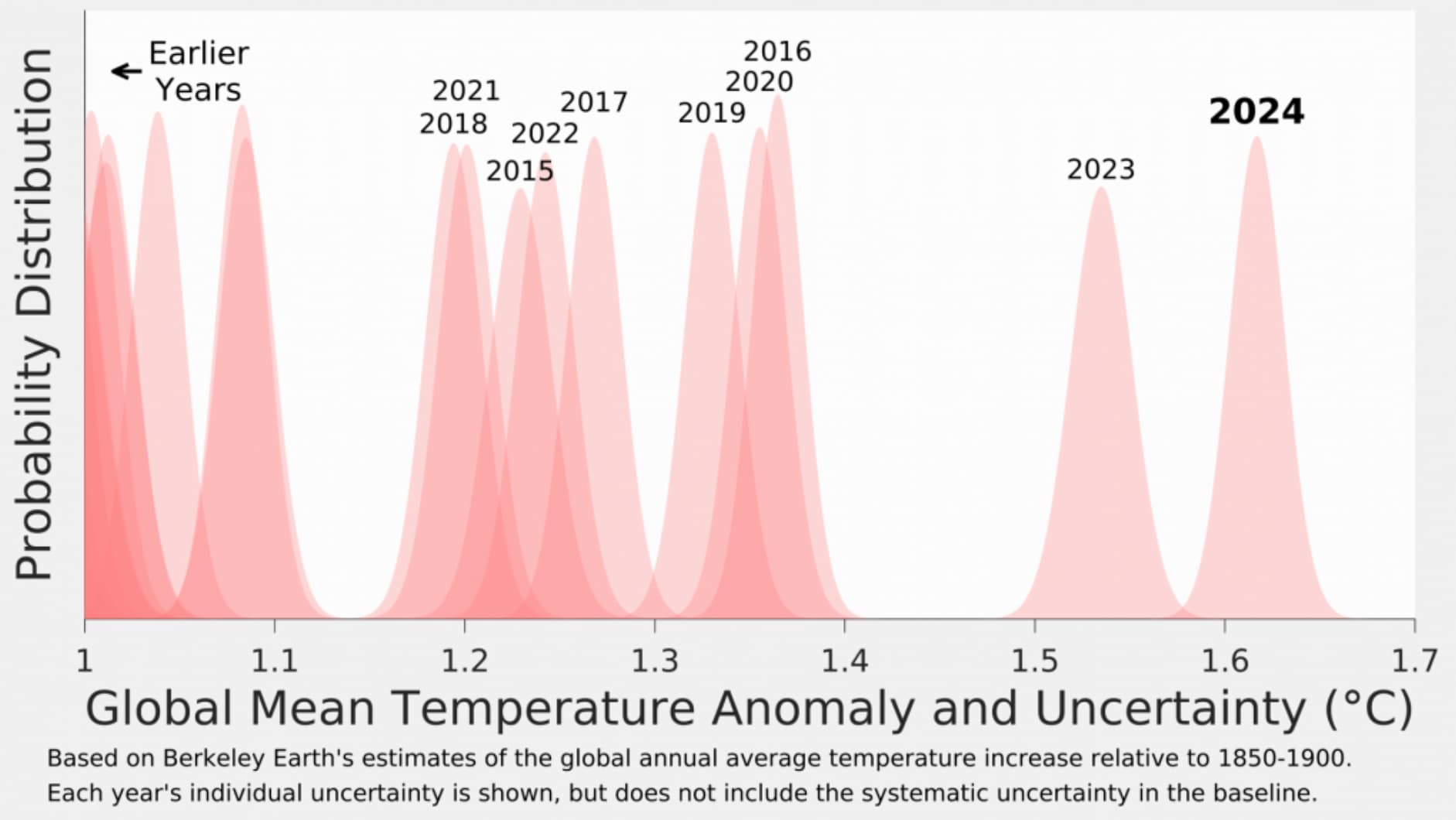
The year 2024 was the warmest on record for both the world’s land and ocean regions. Global average land temperatures were around 2.3C above pre-industrial levels in the Berkeley Earth dataset, while global ocean temperatures exceeded 1.1C.
The figure below shows land (red) and ocean (blue) temperatures along with their respective confidence intervals, relative to pre-industrial levels, in the Berkeley Earth surface temperature record.
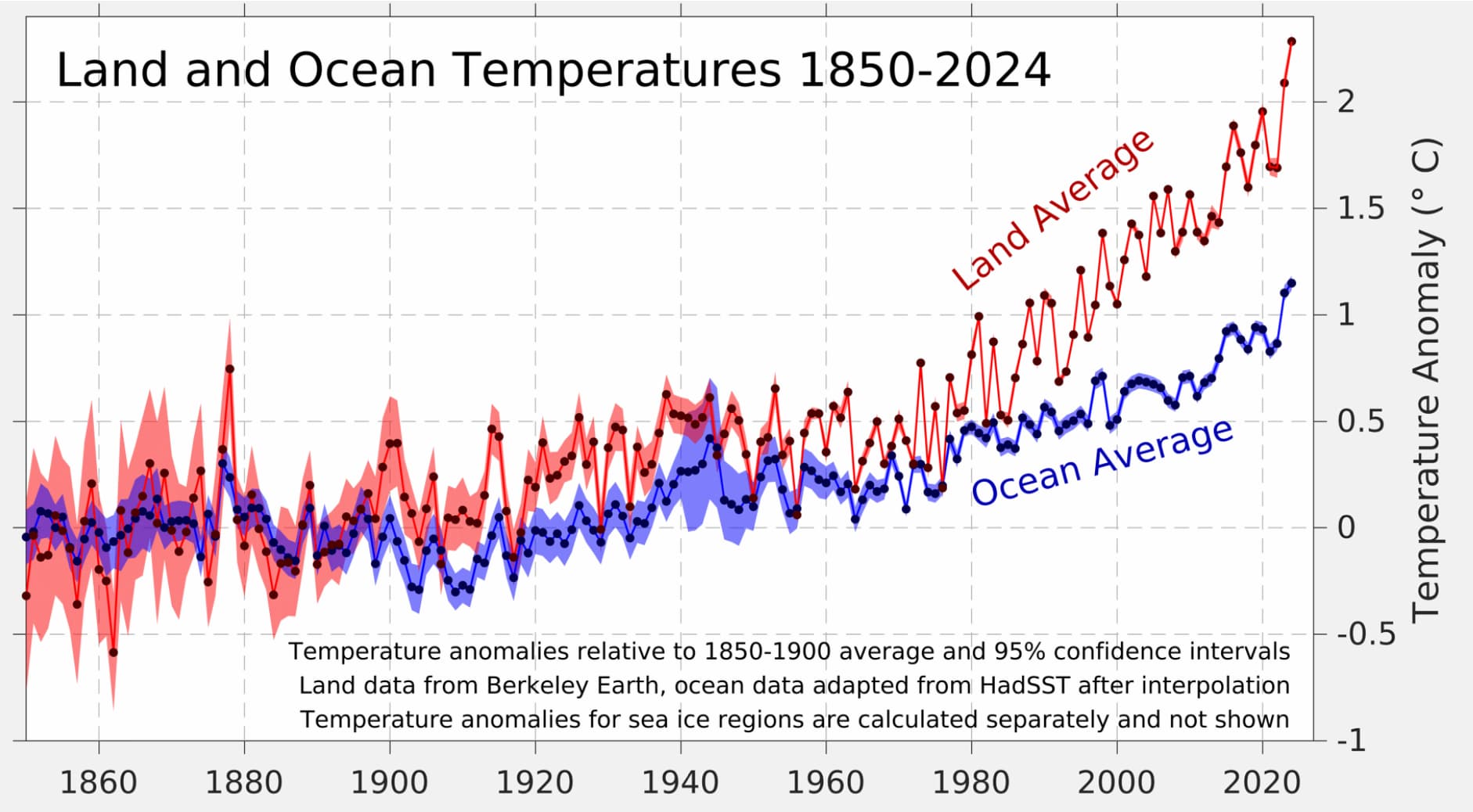
Global land regions – where the global human population lives – has been warming around 70% faster than the oceans – and 40% faster than the global average in the years since 1970.
2024 started off quite hot, boosted by an El Niño event that peaked at the start of the year. The first six months of the year set new all-time monthly records, extending a run of 15 record-setting months that started in July 2023. The latter part of the year remained warm, and was only slightly exceeded by the exceptionally hot temperatures experienced in the second half of 2023.
The figure below shows each month of 2024 in black, compared to all prior years since 1940. Each year is coloured based on the decade in which it occurred, with the clear warming over time visible, as well as the margin by which both 2023 and 2024 exceeded past years.

First year above 1.5C in most records
In the 2015 Paris Agreement, countries agreed to work to limit global temperatures to “well below 2C” and to pursue efforts to limit the temperature increase to 1.5C above pre-industrial levels”.
While the agreement did not specifically define how to measure the breach of these climate targets, the goals have been widely interpreted (including by the IPCC) to refer to temperature averages over 20 years.
In other words, the limits refer to long-term warming, rather than an individual year that includes the short-term influence of natural fluctuations in the climate, such as El Niño.
However, a single year exceeding 1.5C still represents a grim milestone and a sign that the world is quickly approaching the target. And, in the majority of datasets in 2024, global surface temperatures exceeded 1.5C for the first time. (In the Berkeley Earth dataset, 2023 was actually the first year above 1.5C.)
| Temperature record | 2024 temperatures relative to preindustrial |
|---|---|
| NASA GISTEMP | 1.47C |
| Hadley/UAE HadCRUT5 | 1.53C |
| NOAA GlobalTemp | 1.46C |
| Berkeley Earth | 1.62C |
| Copernicus/ECMWF | 1.60C |
| JRA-3Q | 1.59C |
| Japanese Meteorological Agency | 1.52C |
NOAA and NASA were the only organisations to report global temperatures below 1.5C – and by just a few hundredths of a degree. Berkeley Earth, Copernicus and JRA-3Q all estimated that temperatures were around 1.6C.
This year, the World Meteorological Organization (WMO) provided a synthesis of the different global surface temperature records – incorporating NASA, Hadley, NOAA, Berkeley, Copernicus and JRA-3Q data – which is a useful tool to provide a best-estimate across the different groups. It finds that 2024 was the first year above 1.5C, coming in at 1.55C compared to 1.45C in 2023.
The figure below shows various temperature records along with their published uncertainty range (where available), alongside the WMO synthesis estimate.
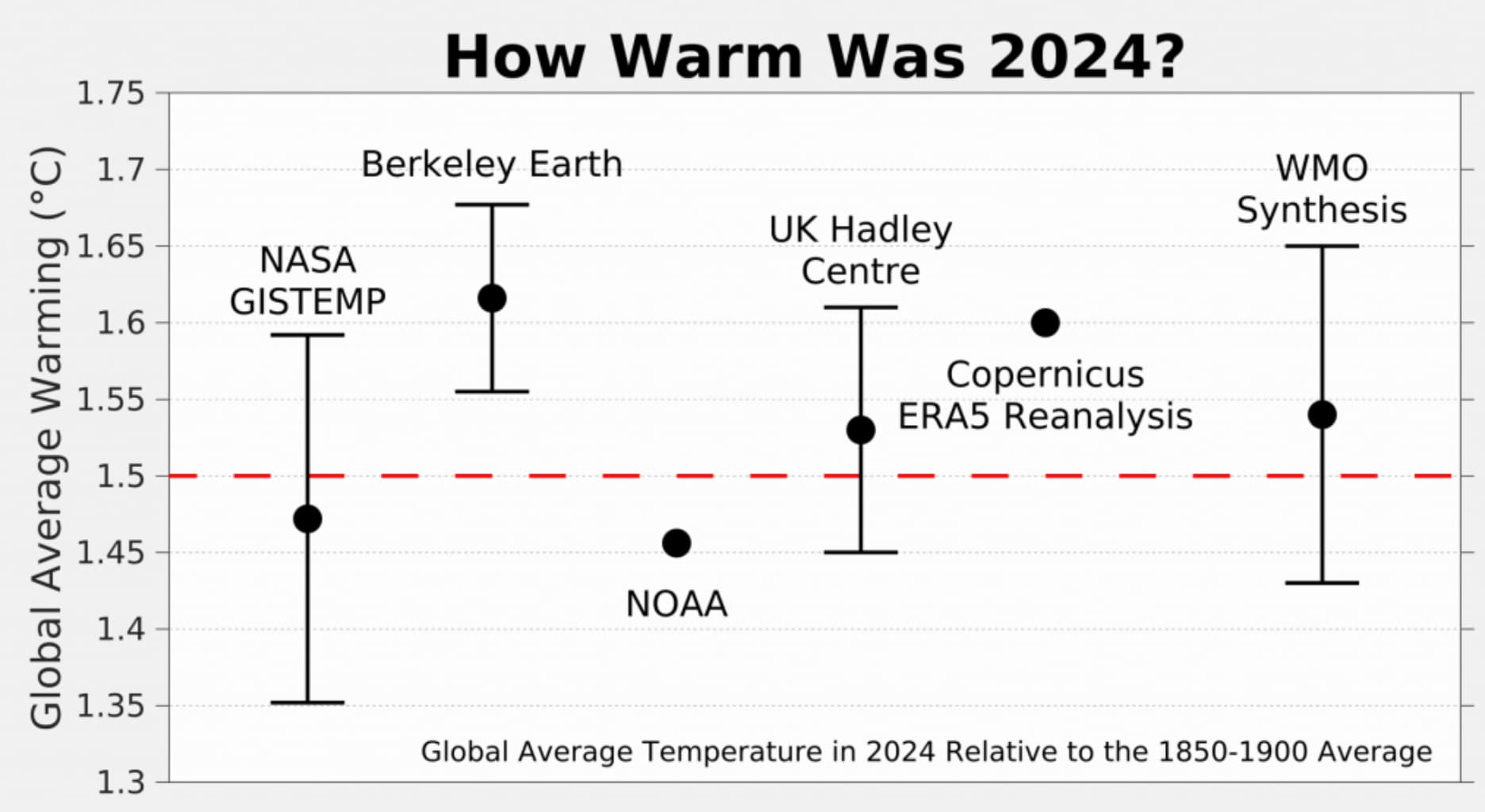
As noted earlier, these datasets are nearly identical over the past 50 years. Differences in warming relative to pre-industrial levels emerge earlier in the record, particularly prior to 1900 when observations are more sparse and the choice of how to fill in the gaps between observations has a large impact on the resulting temperature estimate.
The figure below shows how different temperature records look if each is calculated relative to its own pre-industrial baseline, rather than using an average pre-industrial baseline as shown in the prior section. Focusing on warming since pre-industrial levels – rather than more recent warming – magnifies differences between groups, with the variation in warming across groups largely due to the most uncertain early part of the record.
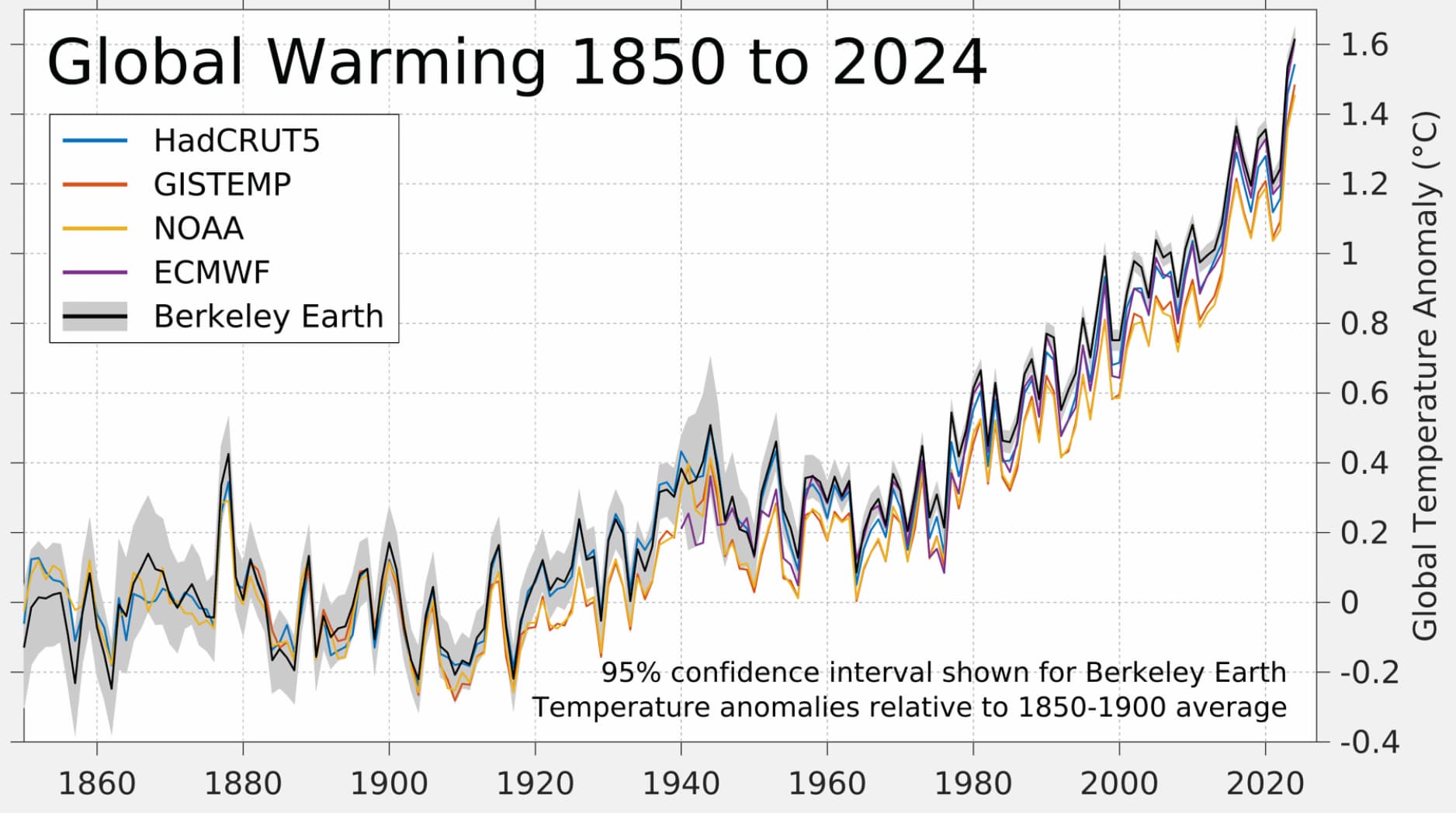
Ocean heat content sets another record
Last year was the warmest on record for the heat content of the world’s oceans. Ocean heat content (OHC) has increased by around 484 zettajoules – a billion trillion joules – since the 1940s. The heat increase in 2024 alone compared to 2023 – about 16 zettajoules – is around 25 times as much as the total energy produced by all human activities on Earth in 2023 (the latest year in which global primary energy statistics are available).
Human-emitted greenhouse gases trap extra heat in the atmosphere. While some of this warms the Earth’s surface, the vast majority – around of 93% – goes into the oceans. About two-thirds of this accumulates in the top 700 metres, but some also ends up in the deep oceans.
The figure below shows annual OHC estimates between 1950 and present for the upper 700 metres (light blue shading) and 700-2,000 metres (dark blue) of the ocean.
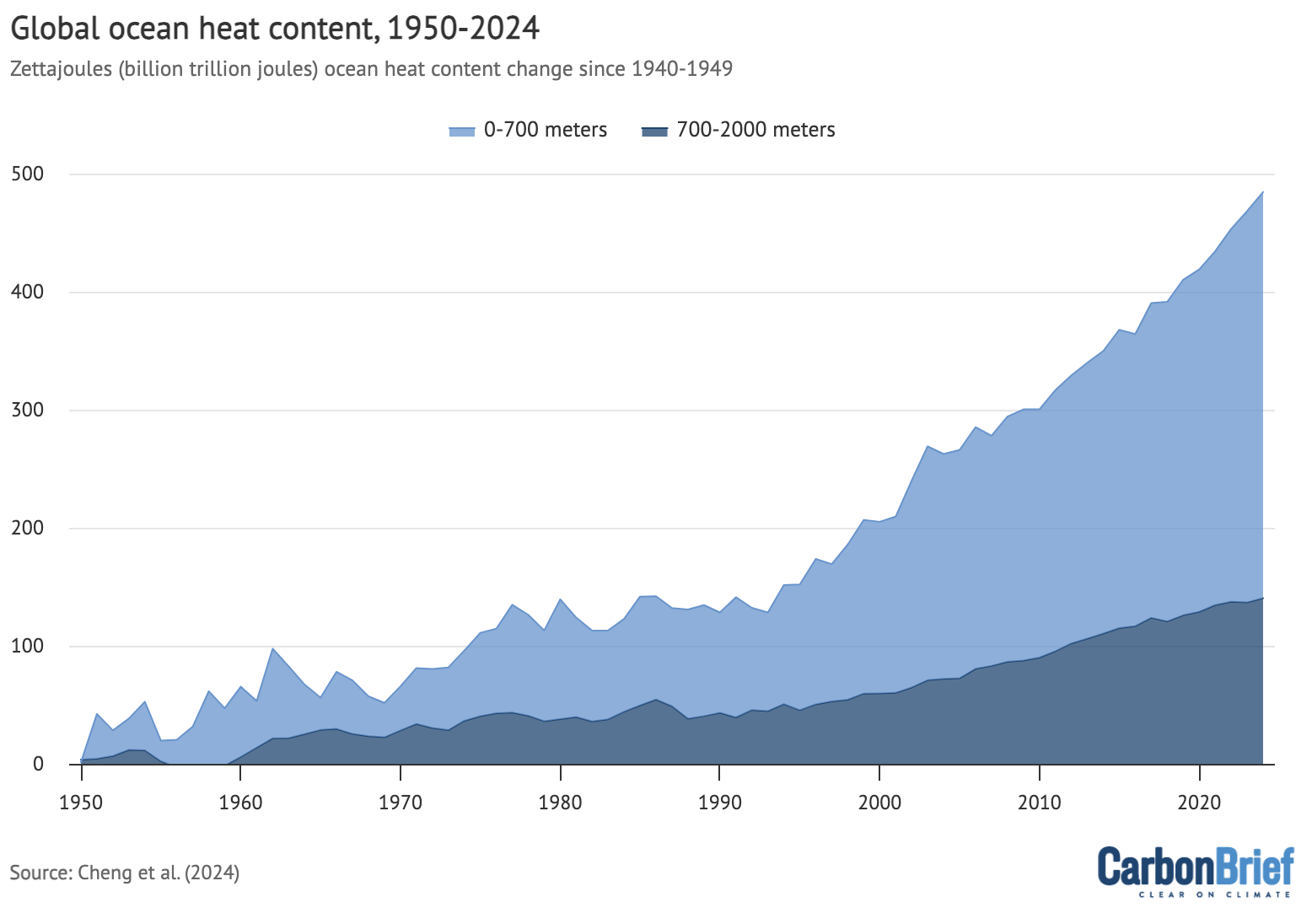
In many ways, OHC represents a much better measure of climate change than global average surface temperatures, because it is where most of the extra heat ends up and is much less variable on a year-to-year basis than surface temperatures.
The graph above shows a distinct acceleration in OHC after 1991, matching the increased rate of greenhouse gas emissions and other radiative forcing elements over the past few decades.
A year of climate extremes
While media coverage of 2024 temperatures has largely focused on the global average, many different regions of the planet experienced climate extremes.
The figure below shows global temperature anomalies in 2024 across the world, with the red areas warmer than the baseline period (1951-80) used by Berkeley Earth and the (few) blue areas experiencing cooler temperatures.
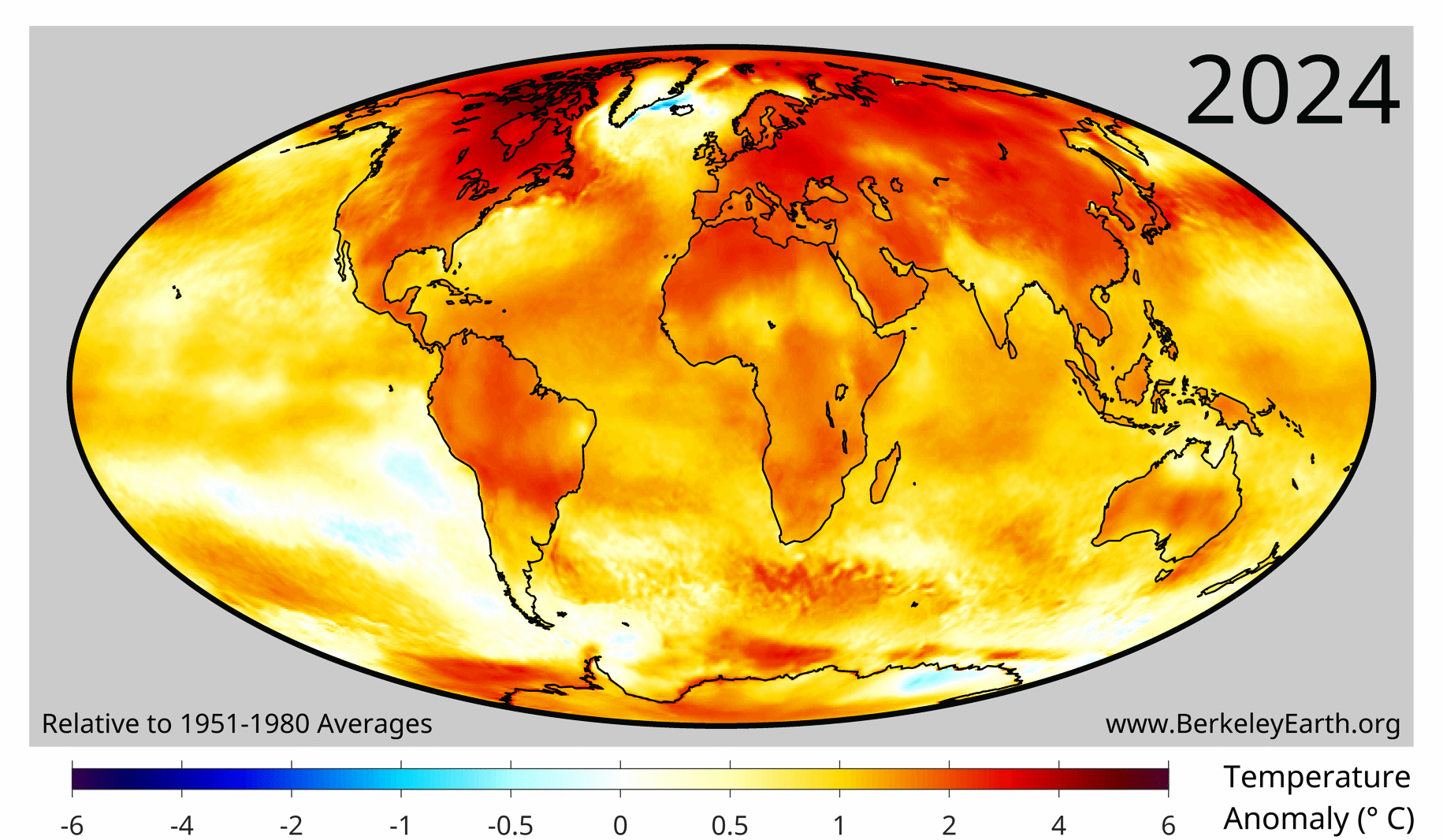
Approximately 3.3 billion people – 40% of Earth’s population – live in places that experienced their warmest year on record in 2024. This was concentrated in Asia, South and Central America, Africa, and Eastern Europe. It also includes two-thirds of the population of China, as well as most of the population of Brazil, Nigeria, Ethiopia, Mexico and one-third of the population of the US.
The figure below highlights regions of the planet that experienced their top-five warmest (red shading) or coldest (blue) temperatures on record in 2024. Overall, around 24% of the planet set a new record, including 32% of the land and 21% of the ocean. No location on the planet experienced record cold temperatures (or even top-five record cold temperatures) for the year as a whole.
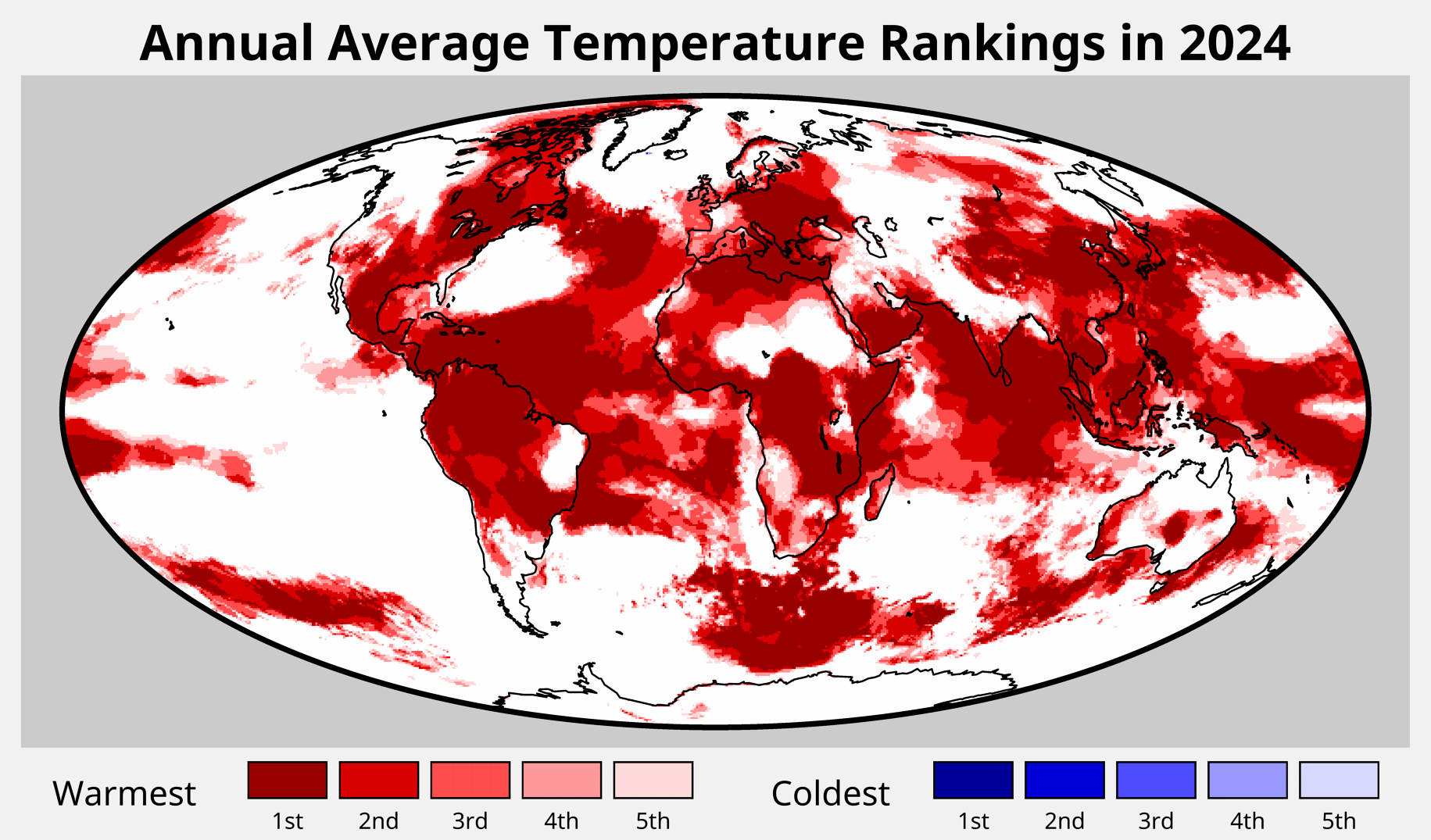
In 2024, more than 100 countries saw their warmest year on record, as listed in the table below.
| Africa | Asia | Europe | North America | Oceania | South America |
|---|---|---|---|---|---|
| Algeria Cameroon Central African Republic Chad Comoros Democratic Republic of the Congo Djibouti Equatorial Guinea Eritrea Ethiopia Gabon Ghana Guinea Guinea-Bissau Ivory Coast Kenya Liberia Libya Malawi Mozambique Republic of the Congo Sao Tome and Principe Seychelles Sierra Leone Somalia South Sudan Togo Tunisia Uganda Zambia Zimbabwe | Brunei Cambodia China Indonesia Laos Malaysia Mongolia North Korea Oman Palau Philippines Singapore South Korea Sri Lanka Taiwan Thailand Vietnam Yemen | Albania Austria Belarus Bosnia and Herzegovina Bulgaria Croatia Cyprus Czechia Germany Greece Hungary Italy Kosovo Liechtenstein Lithuania Malta Moldova Montenegro Netherlands Poland San Marino Republic of Serbia Romania Slovakia Slovenia Ukraine | Antigua and Barbuda Barbados Belize Canada Dominica El Salvador Grenada Guatemala Haiti Honduras Jamaica Mexico Nicaragua Saint Kitts and Nevis Saint Lucia Saint Vincent and the Grenadines Trinidad and Tobago | Federated States of Micronesia Fiji Kiribati Samoa Solomon Islands | Brazil Colombia Guyana Paraguay Suriname Venezuela |
While the contiguous US saw record warmth, 2024 was the country’s second-warmest year on record once Alaska and Hawaii temperatures are included.
Furthermore, the continents of North America, South America, Asia, Africa and Europe each set new annual average records in 2024.
Untangling the drivers of spiking global temperatures
Global temperatures spiked in both 2023 and 2024 in a manner that scientists had not anticipated. Projections of 2023 temperatures were far below what actually occurred, and even 2024 projections ended up being on the lower end, despite incorporating 2023’s extremes.
The figure below shows estimates by four different groups that provided temperature predictions for the year prior to any data being collected – the UK Met Office, NASA’s Dr Gavin Schmidt, Berkeley Earth and Carbon Brief’s own estimate.
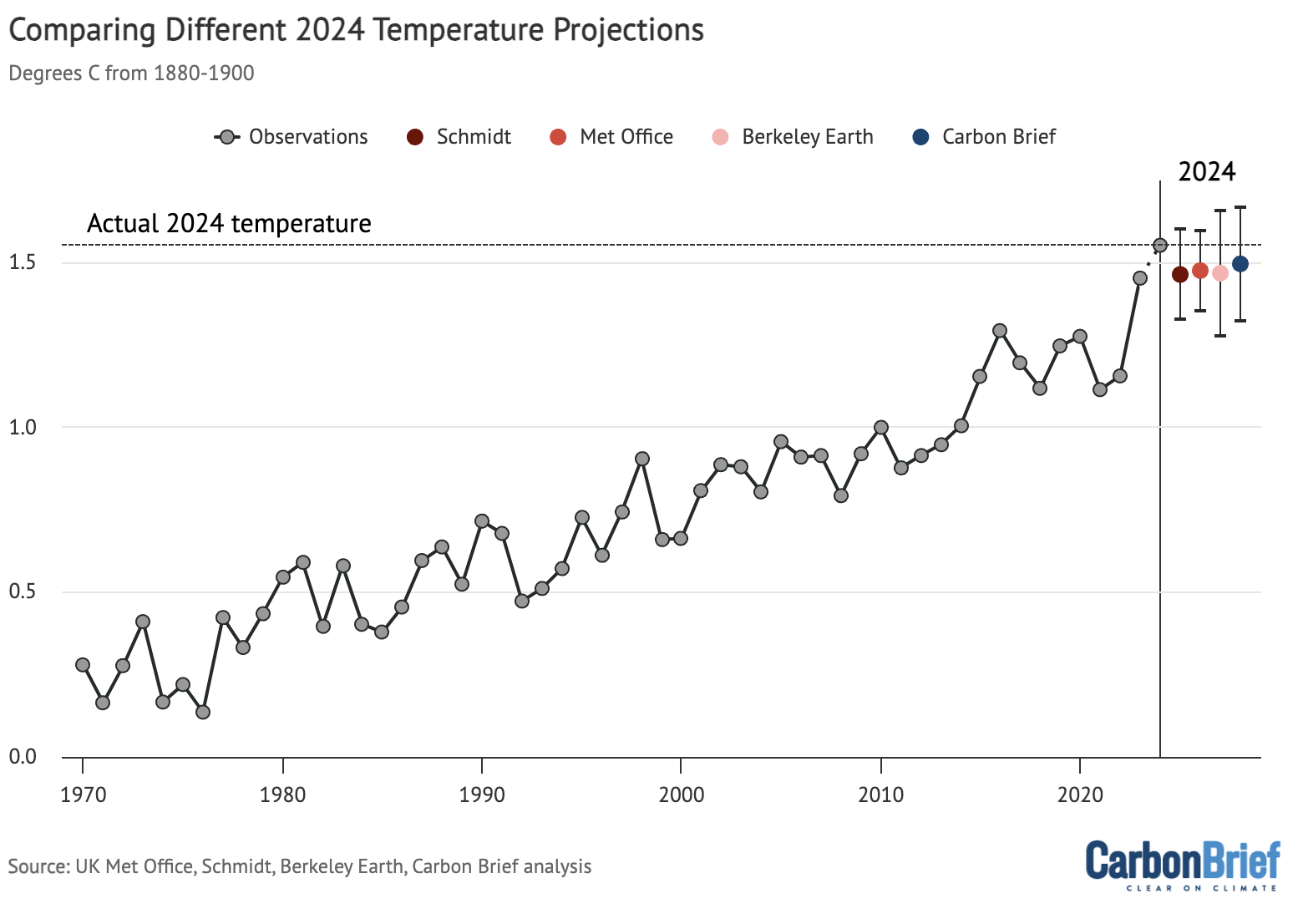
Unusually high global temperatures in 2023 and 2024 have sparked a slew of new studies by scientists attempting to explain the excessive heat. A range of possible causes has been proposed, including:
- The possibility that El Niño behaved unusually as it followed a rare extended triple-dip La Niña event. A 2024 paper found that when El Niño followed an extended La Niña in climate model simulations, it produced a temperature spike commensurate to what was observed in 2023-24 around 10% of the time.
- A decline in emissions of sulphur dioxide, reducing atmospheric aerosol concentrations and “unmasking” additional warming from past human greenhouse gas emissions. Multiple different papers have looked at the effects of a 2020 low-sulphur marine shipping fuel regulation, and ongoing research is looking at the effects of a sharp drop in sulphur emissions in China.
- An unusual 2022 eruption of the Hunga-Tonga Hunga Ha’apai volcano that put around 150m tonnes of water vapour into the stratosphere, as well as some sulphur dioxide. Papers have been mixed on whether the water vapour warming or the sulphur dioxide cooling would be larger.
- Other factors include an uptick in the 11-year solar cycle, and unusually low Saharan dust concentrations in early summer 2023.
One notable paper, published in the journal Science in early December 2024, found a substantial decline in reflective low-cloud cover in the northern mid-latitudes and tropics. They noted that this has the effect of increasing the amount of solar radiation that reaches the Earth’s surface and is re-radiated as heat.
The finding by itself does not reveal what caused a decline in cloud reflectivity, and the authors note that it could be a combination of natural variability, declining atmospheric aerosol concentrations associated with falling sulfur emissions, or – more worryingly – a sign of a strong positive cloud feedback associated with warming.
The figure below, created by Dr Robert Rohde at Berkeley Earth, synthesises the main drivers of temperature change over the past decade. It includes estimates of the warming contribution from human greenhouse gas emissions, El Niño and La Niña, changes in the solar cycle, the Hunga-Tonga eruption, and the 2020 low-sulphur marine fuel regulations. For the latter two elements, it includes a range of six published estimates of the eruption and five published estimates of the low sulphur fuel rules.
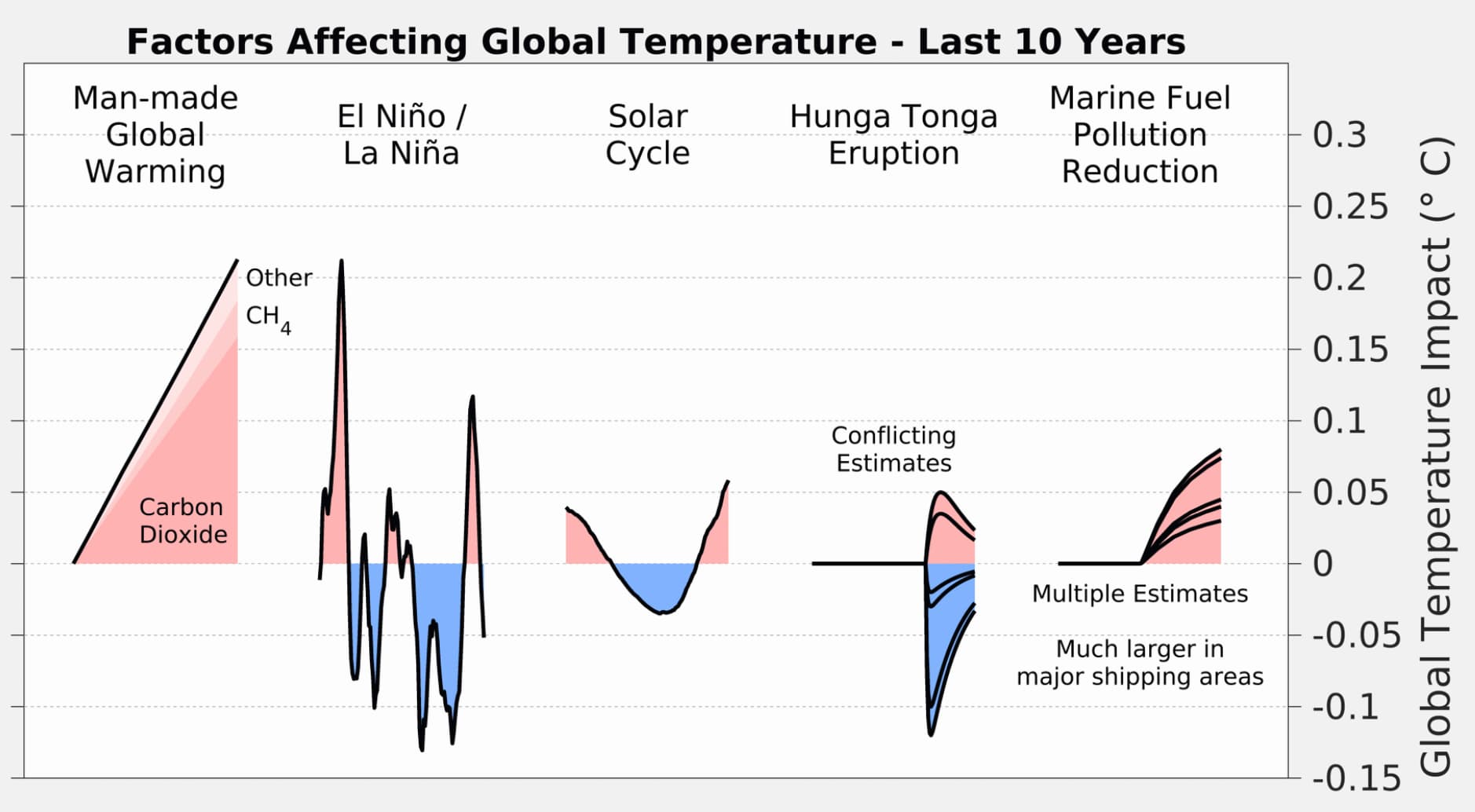
Over the longer-term, human emissions of CO2 and other greenhouse gases alongside planet-cooling aerosols are the main driver of global temperatures. Global temperatures have risen by more than 1.3C since pre-industrial times as a result of human activity.
However, on top of long-term warming, global temperatures vary year-to-year by up to 0.2C.
These variations are primarily driven by El Niño and La Niña events that redistribute heat between the atmosphere and oceans. However, other factors such as volcanic eruptions, the 11-year solar cycle and changes in short-lived climate forcers can influence year-to-year temperature changes.
The figure below shows the El Niño (red shading) and La Niña (blue) conditions over the past 40 years (collectively referred to as the El Niño-Southern Oscillation, or “ENSO”). While not unprecedented, the extended La Niña conditions since the latter half of 2020 have extended for an unusually long period of time.
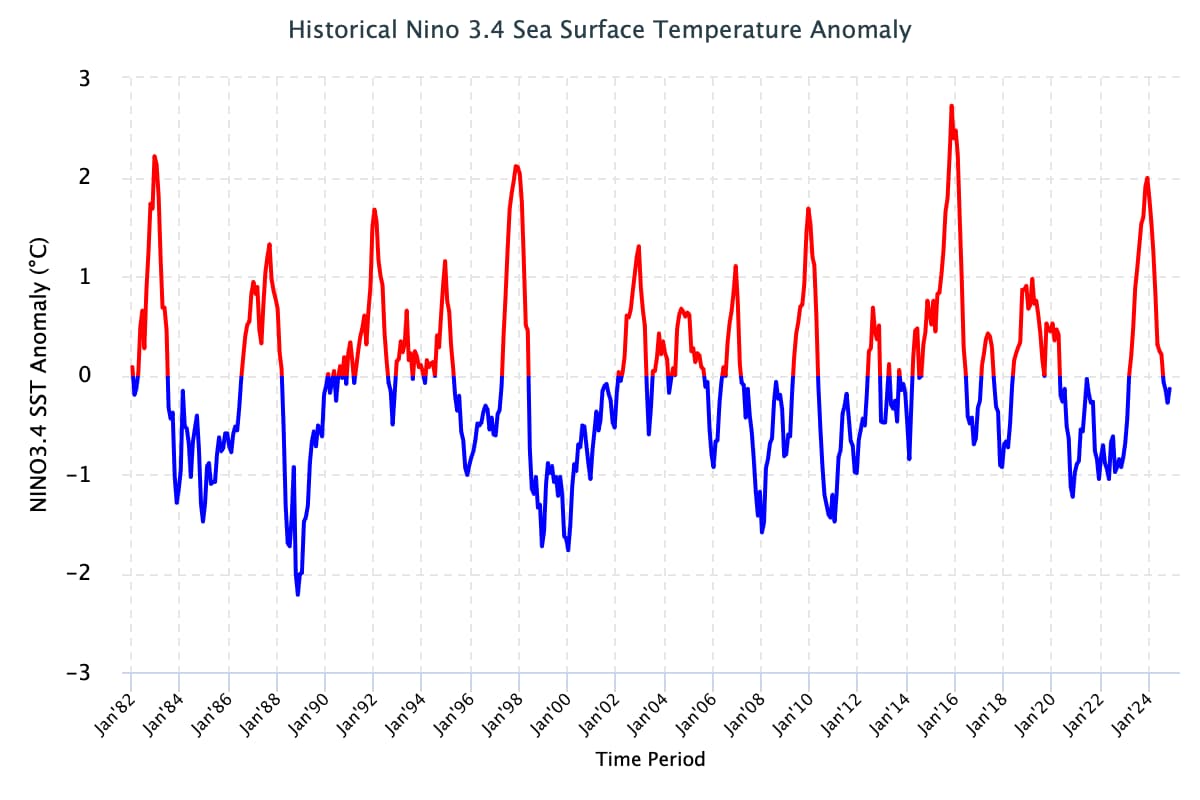
Carbon Brief has used this historical relationship between ENSO conditions and temperature to effectively remove the effects of El Niño and La Niña events from global temperatures, as shown in the figure below.
This analysis indicates that El Niño boosted global temperatures in 2024 by around 0.16C compared to the estimate of global temperatures with both El Niño and La Niña events removed. This was a much larger effect than the 0.04C estimated for 2023, when El Niño emerged relatively late in the year and peaked in November.
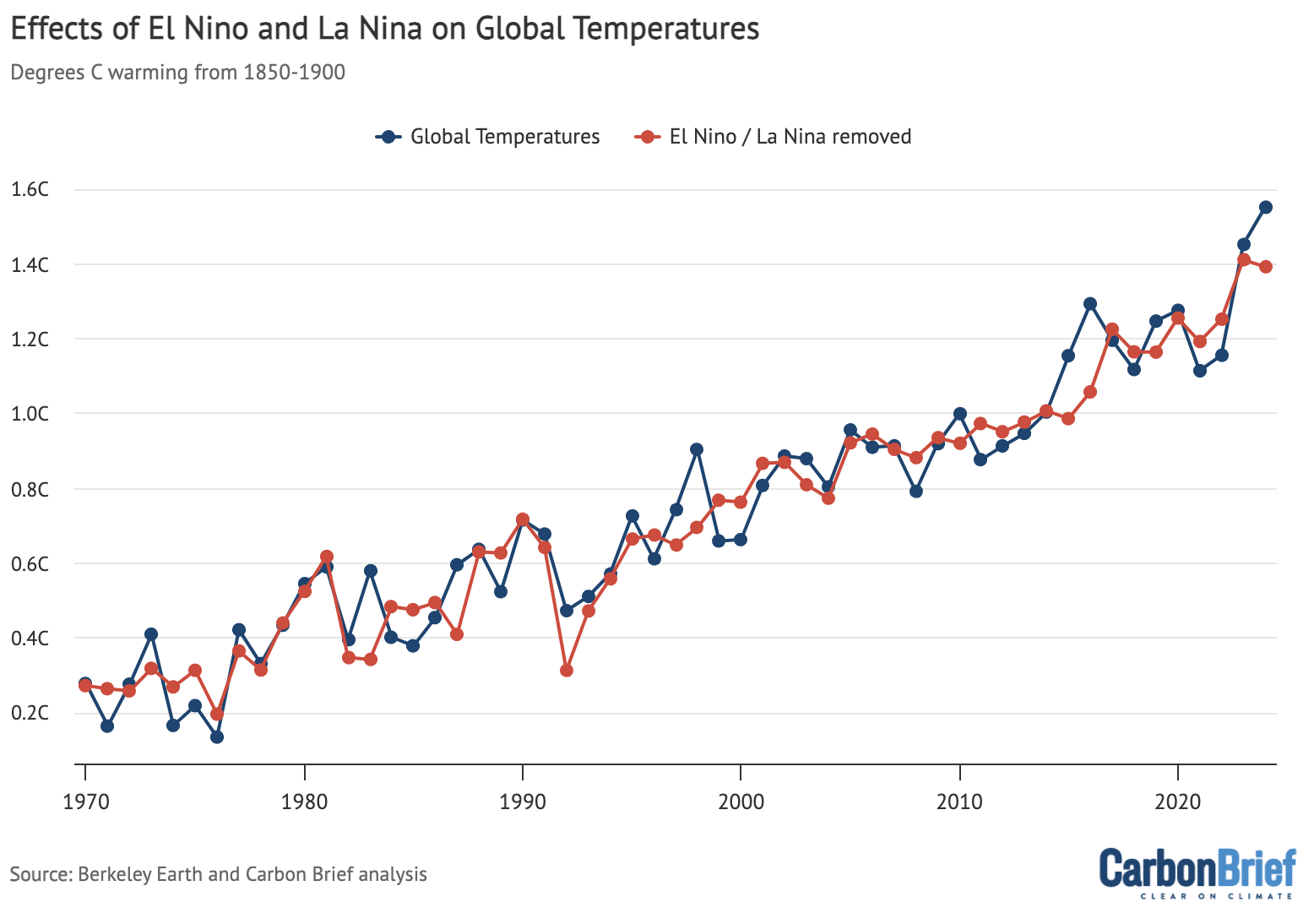
However, this approach – which relies on a historical lag of around three months between peak ENSO conditions in the tropical Pacific and global surface temperature response – may not fully reflect El Niño effects on 2023. As discussed earlier, the fact that El Niño occurred on the heels of unusually-long La Niña conditions may have contributed to an earlier global temperature response than has been seen in other recent strong El Niño events.
Observations broadly in line with climate model projections
Climate models provide physics-based estimates of future warming given different assumptions about future emissions, greenhouse gas concentrations and other climate-influencing factors.
Here, Carbon Brief examines a collection of climate models – known as CMIP6 – used in the 2021 science report of the IPCC’s sixth assessment. In CMIP6, model estimates of temperatures prior to 2015 are a “hindcast” using known past climate influences, while temperatures projected from 2015 onward are a “forecast” based on an estimate of how things might change.
The figure below shows how observations compare to the full ensemble of 37 CMIP6 models (under the middle-of-the-road SSP2-4.5 emissions scenario for future projections). The blue line represents the average of all the models and the grey areas showing the 5th to 95th percentile range. Observational temperatures are plotted on top of the climate model data, with individual observational records represented by red lines of different shades.
The chart illustrates how observations have generally been below the model average over the past two decades and are slightly above model average in 2024.
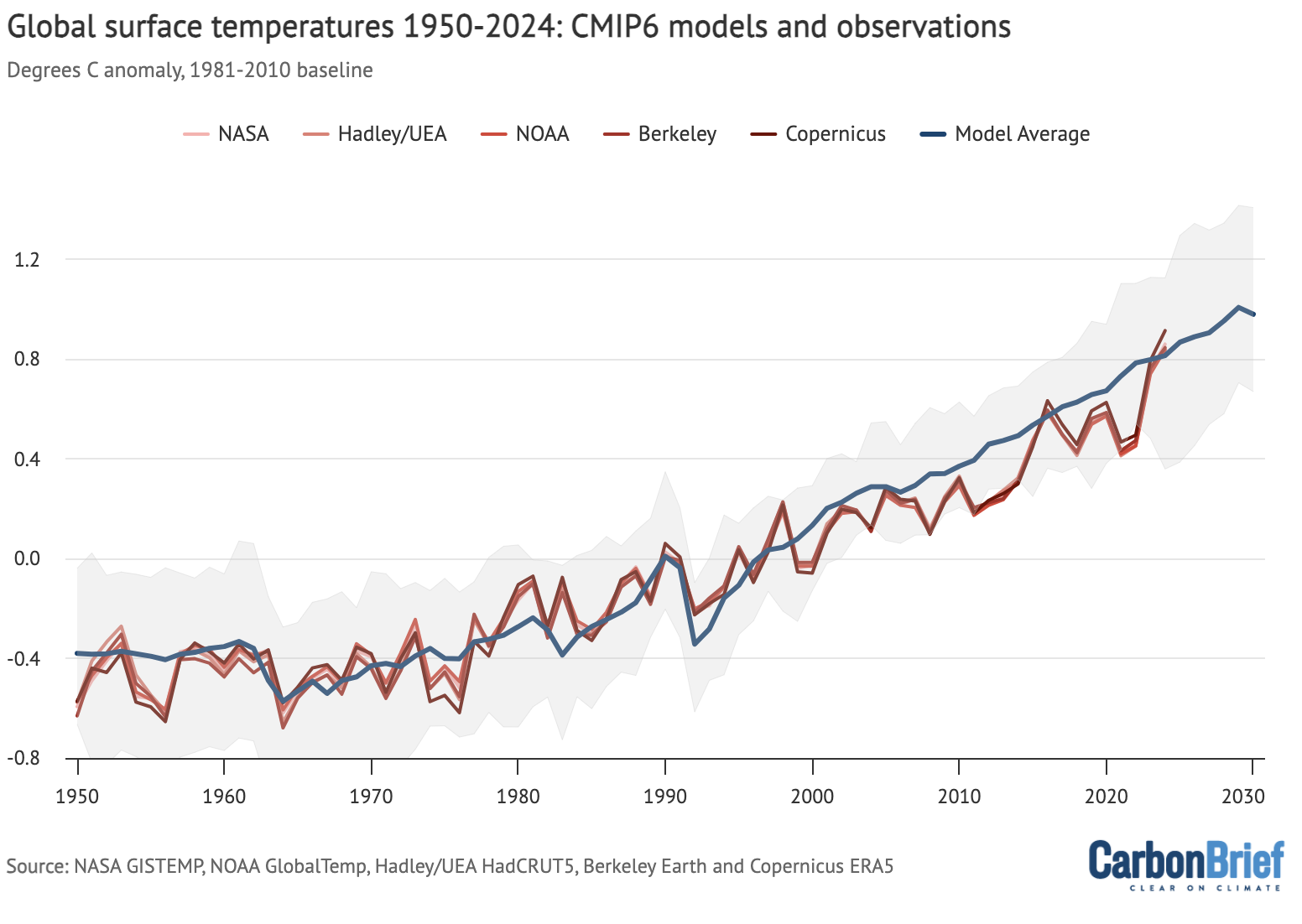
The CMIP6 ensemble is marginally more challenging for this comparison than past generations of CMIP because a subset of its models have unrealistically high climate sensitivity and they reproduce historical observations poorly. To account for this, rather than simply averaging all the models – as had been done in prior assessments – the IPCC employed an approach that effectively weights models by their performance. As a result, the models align better with the range of climate sensitivity derived from multiple different lines of evidence.
In the chart below, the blue line shows the average of 22 different models whose transient climate response (TCR) falls within the IPCC’s “likely” range (which results in temperature projections nearly identical to the IPCC-assessed warming). The grey area shows the 95% (two standard deviation) range of the TCR-screened model projections.
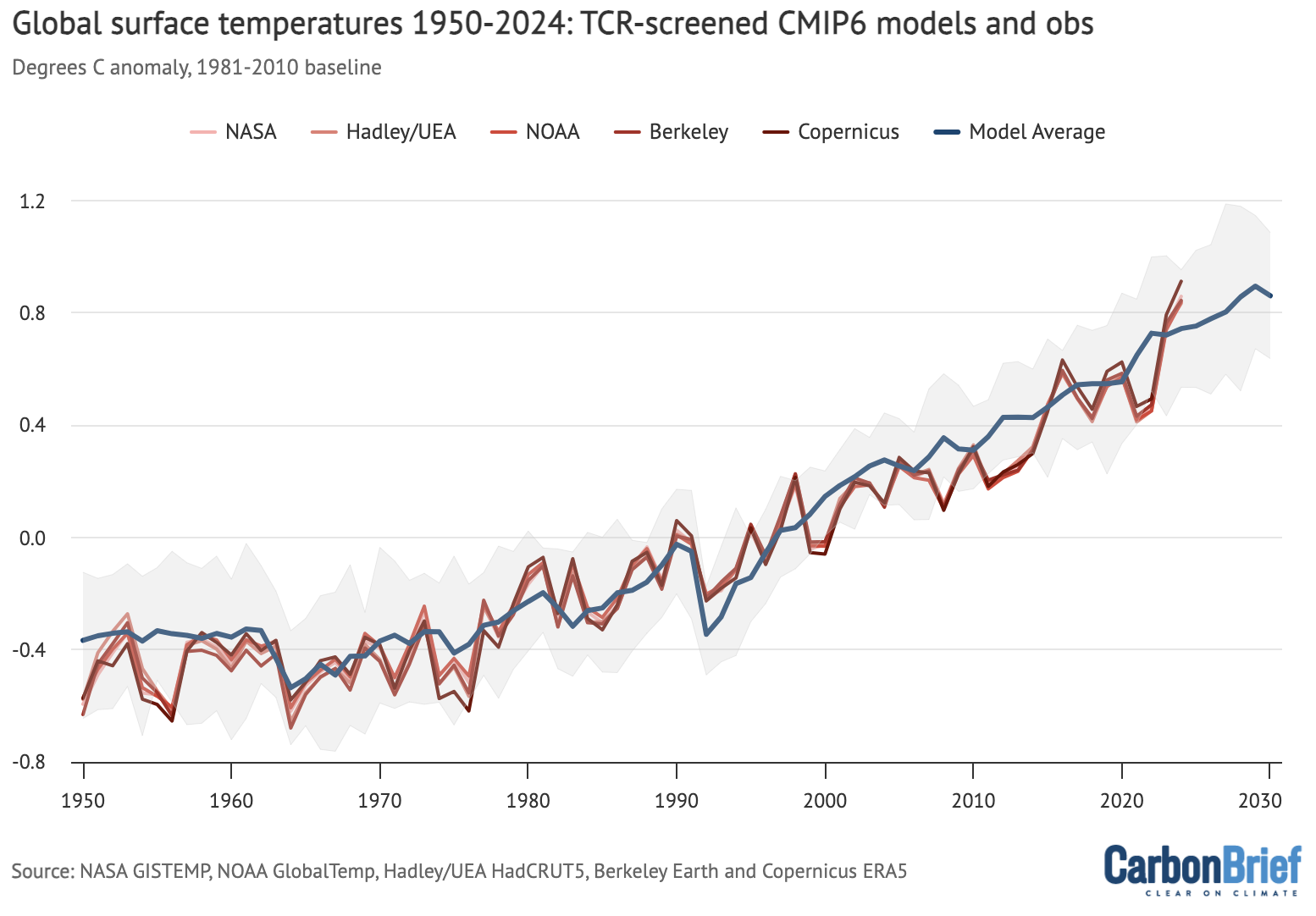
The chart reveals that observed global surface temperatures (red lines) are further above the multimodal average, but remain well within the range of TCR-screened model runs.
This might be surprising given the focus on 2023 and 2024 being unusually warm. However, climate models broadly expect an acceleration of warming in the current period in a scenario like SSP2-4.5 where emissions of CO2 and other greenhouse gases continue to modestly increase, but emissions of planet-cooling aerosols like sulphur dioxide are rapidly reduced.
Record atmospheric temperatures
In addition to surface measurements over the world’s land and oceans, satellite microwave sounding units have been providing estimates of temperatures at various layers of the atmosphere since 1979.
The lowest layer of the atmosphere that satellite microwave units provide temperature estimates for is the lower troposphere. This data reflects temperatures a few kilometres above the Earth’s surface. It reveals a pattern of warming in the lowest troposphere that is similar – though not identical – to surface temperature changes.
The records produced by Remote Sensing Systems (RSS), the University of Alabama, Huntsville (UAH) and NOAA show 2024 as the warmest year on record in the lower troposphere. The chart below shows the three records for the lower troposphere.
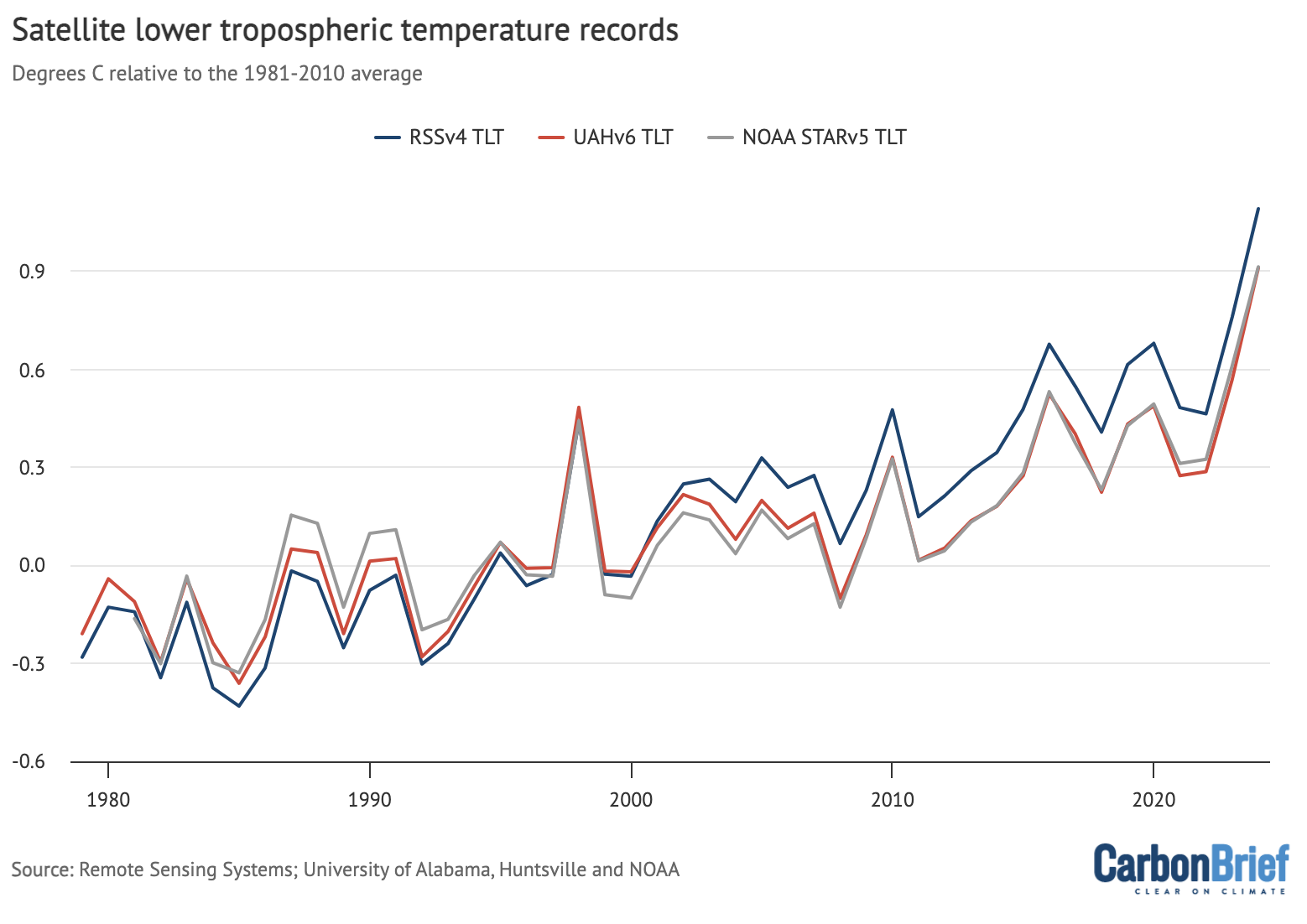
The lower troposphere tends to be influenced more strongly by El Niño and La Niña events than the surface. Therefore, satellite records show correspondingly larger warming or cooling spikes during these events. This explains why the year-on-year increase in lower-troposphere temperature – of around 0.3C – seen in 2024 is larger than the ~0.1C increase in surface records.
The lower-tropospheric temperature records show large differences after the early 2000s. RSS shows an overall rate of warming quite similar to surface temperature records, while UAH and NOAA show considerably slower warming in recent years than has been observed on the surface.
Greenhouse gas concentrations reach new highs
Greenhouse gas concentrations reached a new high in 2024, driven by human emissions from fossil fuels, land use and agriculture.
Three greenhouse gases – CO2, methane (CH4) and nitrous oxide (N2O) – are responsible for the bulk of additional heat trapped by human activities. CO2 is by far the largest factor, accounting for roughly 42% of the increase in global surface temperatures since the pre-industrial era (1850-1900).
Methane accounts for 28%, while nitrous oxide accounts for around 5%. The remaining 25% comes from other factors including carbon monoxide, black carbon and halocarbons, such as CFCs.
Human emissions of greenhouse gases have increased atmospheric concentrations of CO2, methane and nitrous oxide to their highest levels in at least a few million years – if not longer.
The figure below shows concentrations of these greenhouse gases – in parts per million (ppm) for CO2 and parts per billion (ppb) for methane and nitrous oxide – from the early 1980s through to October 2024 for CO2 and September 2024 for CH4 and N2O (the most recent data currently available).
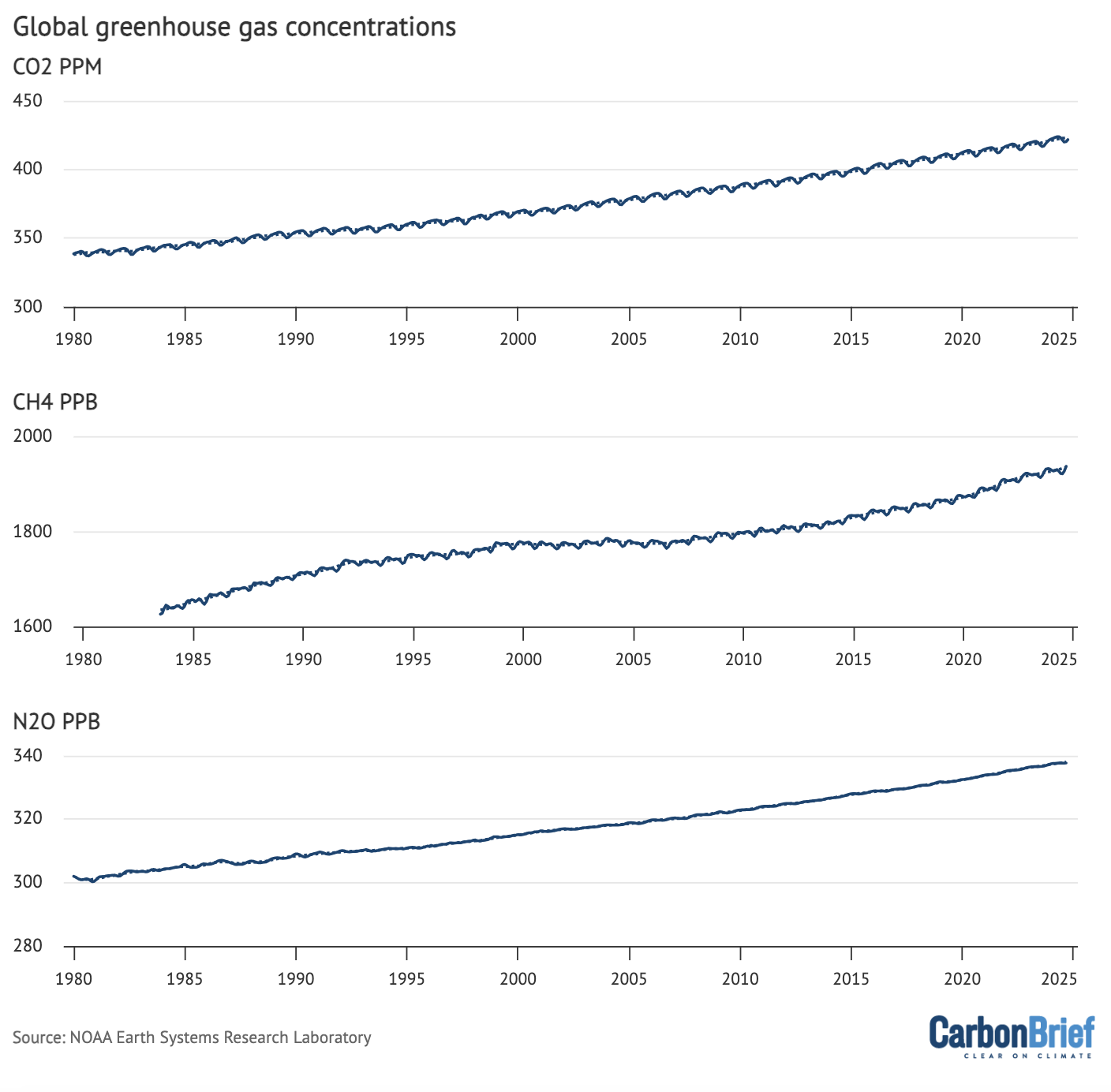
Sea level rise is speeding up
Modern-day sea levels have risen to a new high, due to a combination of melting land ice (such as glaciers and ice sheets), the thermal expansion of water as it warms and changes in land water storage.
In recent years, there have been larger contributions to sea level rise from melting ice sheets and glaciers, as warmer temperatures accelerate ice sheet losses in Greenland and Antarctica.
Since the early 1990s, the increase in global sea level has been estimated using altimeter data from satellites. Earlier global sea levels have been reconstructed from a network of global tide gauge measurements. This allows researchers to estimate how sea level has changed since the late 1800s.
The chart below shows five different modern sea level rise datasets (blue lines), along with satellite altimeter measurements as assessed by NASA (in black) after 1993. (As sea level rise data has not yet been released for the whole year, the 2024 value is estimated based on data through to October.)
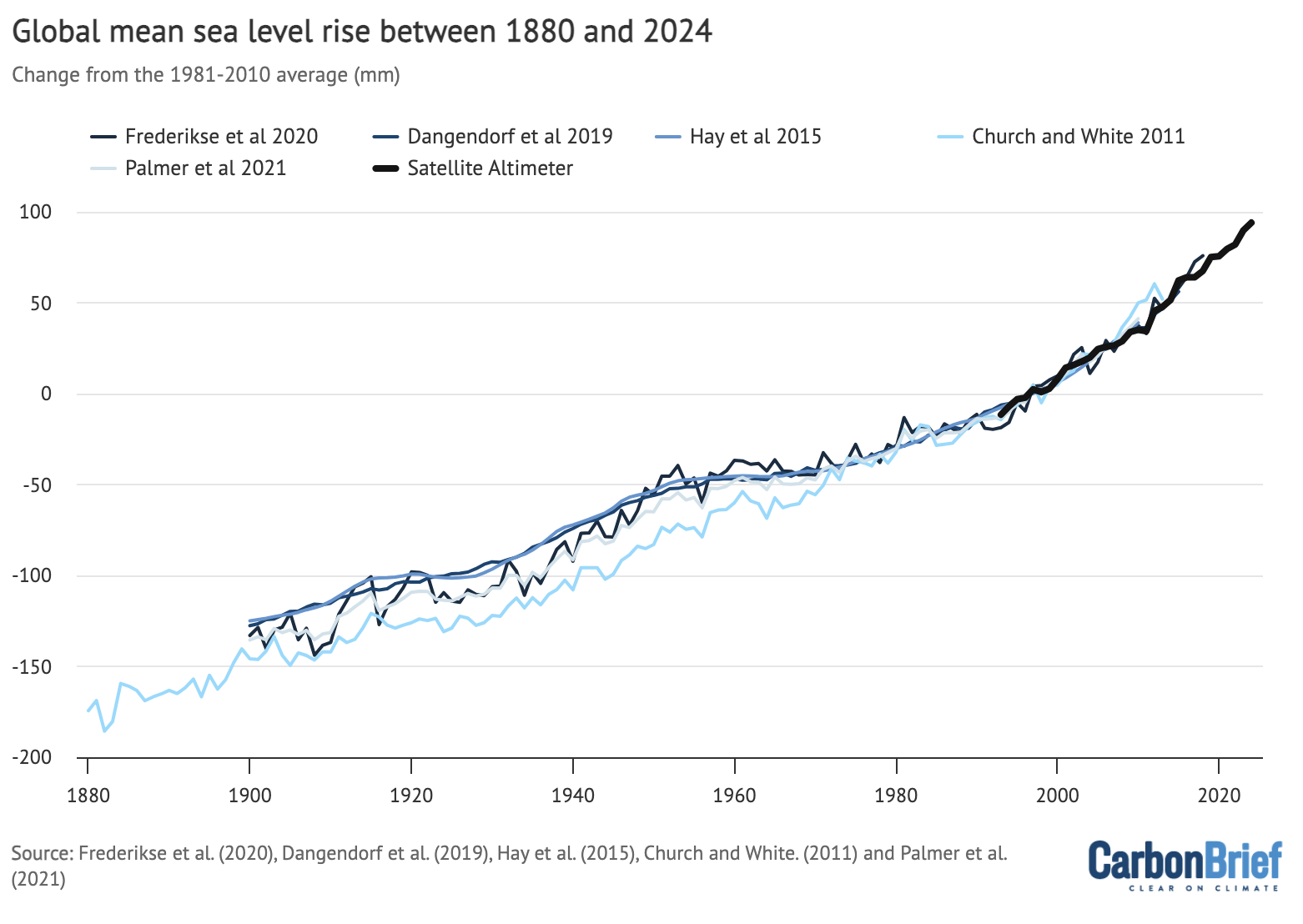
Sea levels have risen by over 0.2 metres (200mm) since 1900. While sea level rise estimates mostly agree in recent decades, larger divergences are evident before 1980. There is also evidence of accelerating sea level rise over the post-1993 period when high-quality satellite altimetry data is available. (See Carbon Brief’s explainer on how climate change is accelerating sea level rise.)
Shrinking glaciers and ice sheets
A significant portion of global sea level rise is being driven by melting glaciers on land. Scientists measure the mass of glaciers around the world using a variety of remote-sensing techniques, as well as through GRACE measurements of the Earth’s gravitational field. The balance between snow falling on a glacier and ice loss through melting and the breaking off – or “calving” – of icebergs determines if glaciers grow or shrink over time.
The World Glacier Monitoring Service is an international consortium that tracks more than 130 different glaciers in 19 different regions around the world. The figure below shows the change in global average glacier mass from 1950 through to the end of 2023. (2024 values are not yet available.) Note that glacier melt is reported in metres of water equivalent, which is a measure of how much mass has been lost on average.
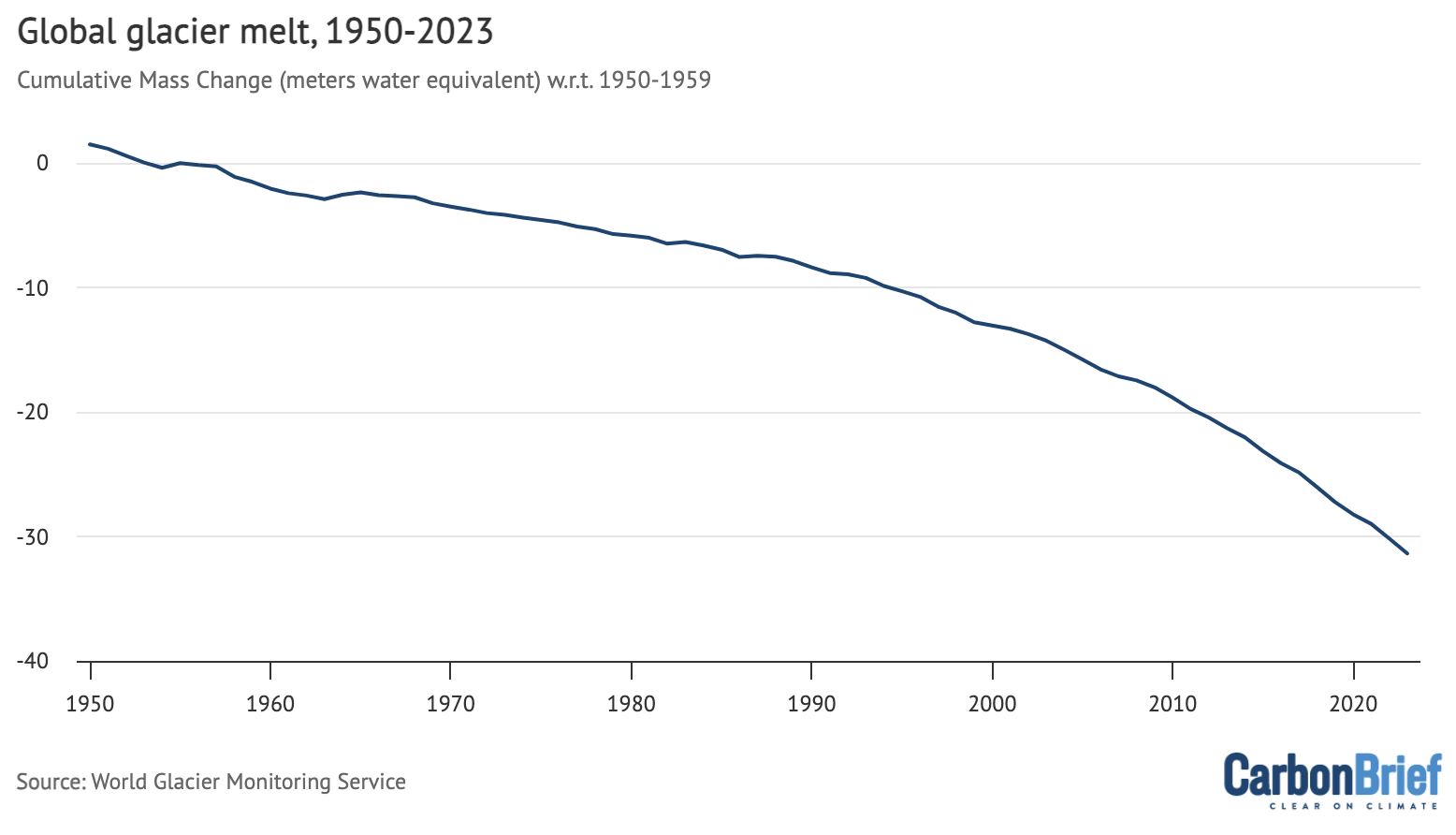
Greenland ice sheets have become a larger contributor to sea level rise in recent years due to accelerating loss of mass. The year 2024 was the 28th in a row where Greenland lost ice overall, with 80bn tonnes of ice lost over the 12 months from September 2023 to August 2024. Greenland last saw an annual net gain of ice in 1996.
The figure below shows the cumulative mass balance change – that is, the net ice loss – from Greenland between 1970 and October 2024. The authors find that Greenland has lost around 6tn tonnes of ice over the past 50 years – more than 700 tonnes lost per person for every person on the planet.
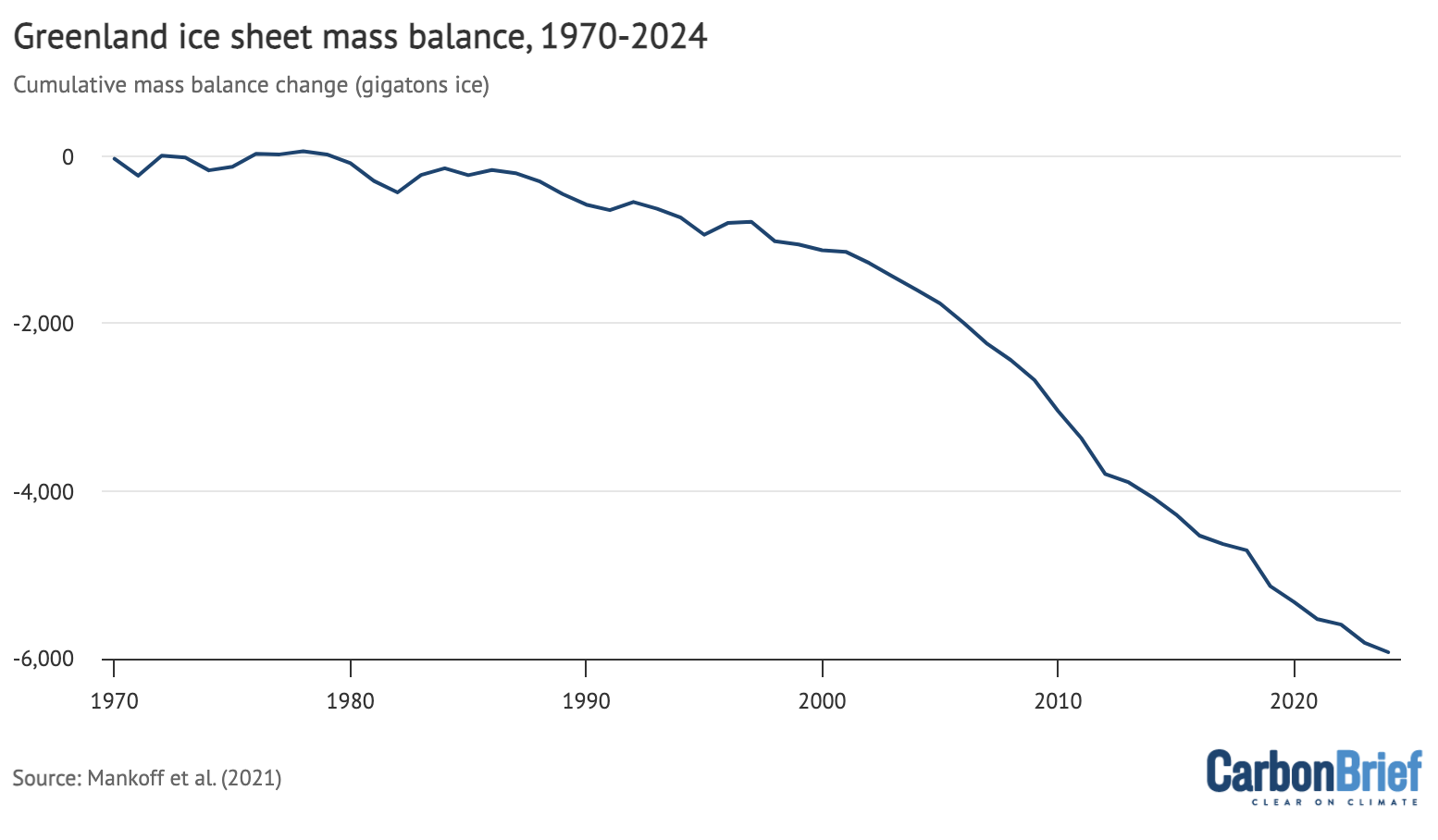
Near-record low Antarctic sea ice extent
Arctic sea ice was at the low end of the historical (1979-2010) range for most of 2024, but did not set any new all-time low records apart from a few individual days at the end of the year.
The summer minimum extent – the lowest recorded level for the year – was the seventh-lowest since records began in the late 1970s.
Antarctic sea ice, on the other hand, was the second lowest on record – after 2023 – for much of the year. Taken together, 2023 and 2024 Antarctic sea ice extent was “way outside anything we have witnessed in our satellite record for their winter months”, an expert told Carbon Brief in October last year.
While long-term trends in Antarctic sea ice have been ambiguous in the past (unlike in the Arctic where there is a consistent long-term decline), there is increasing evidence that human-driven warming is starting to drive significant loss of sea ice in the region.
The figure below shows both Arctic (red line) and Antarctic (blue line) sea ice extent for each day of the year, along with how it compares to the historical range (corresponding shading).
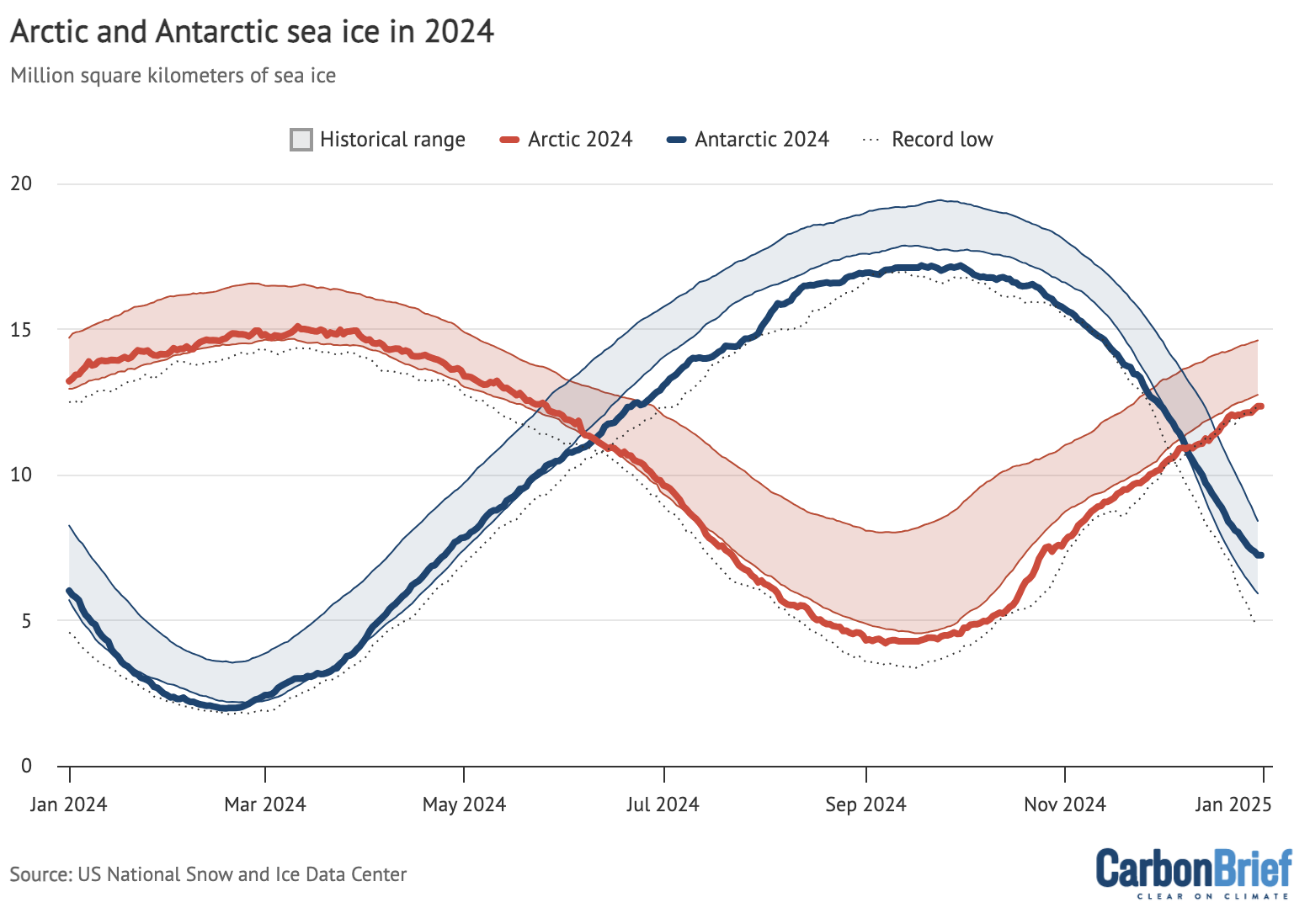
Looking ahead to 2025
There is reason for caution when estimating likely temperatures for 2025. In 2023, temperatures were significantly higher than predictions made at the start of the year, while 2024 temperatures were towards the high end of annual predictions.
At the same time, there is strong reason to expect that 2025 will be cooler than 2024. As noted earlier, 2024 temperatures were boosted by more than 0.1C by a strong El Niño event that has largely faded by the start of 2025. While global land temperatures remain quite elevated, sea surface temperatures have begun to fall in recent months, and weak La Niña conditions are starting to develop in the tropical Pacific.
It seems unlikely that a strong La Niña will develop in 2025, and it is quite possible that the world remains in ENSO neutral conditions with no formal La Niña being declared for the first half of the year. There is even a small chance that the world will re-enter El Niño conditions by the latter part of 2025 – though most models forecast neutral conditions to persist, as shown in the figure below.
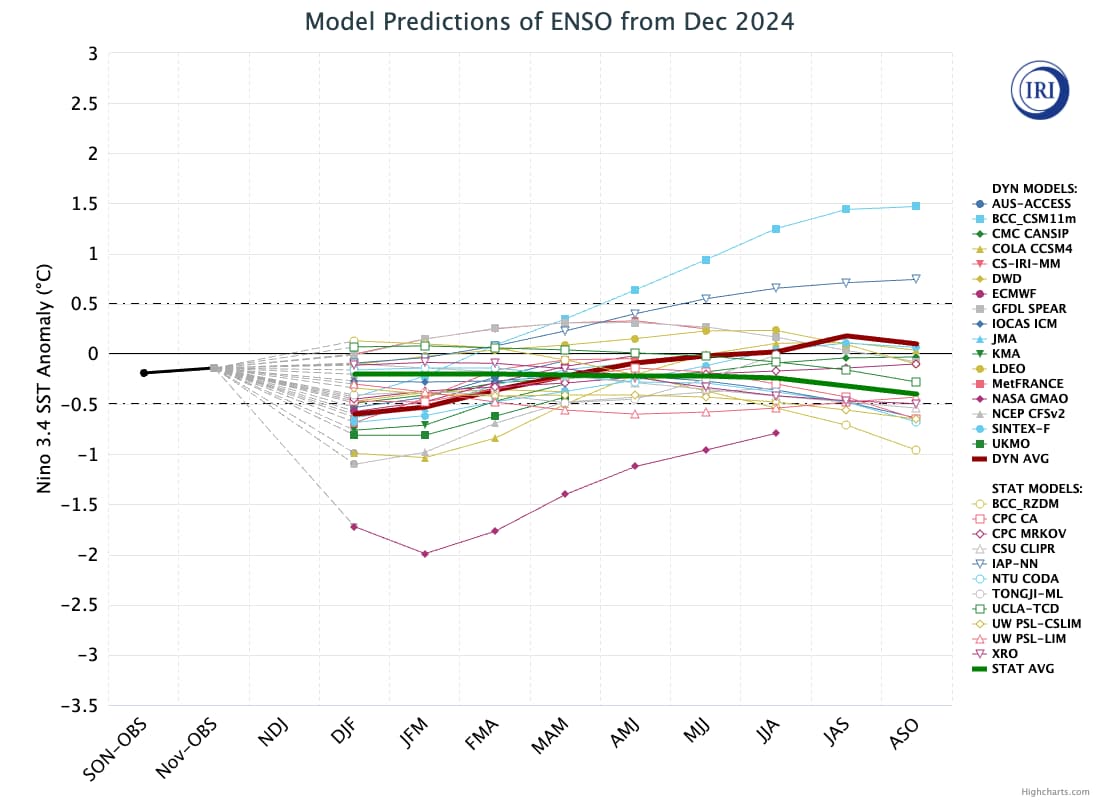
There have been four published predictions – from the UK Met Office, NASA’s Dr Gavin Schmidt, Berkeley Earth and Carbon Brief (in this article) – of what temperatures might look like in 2025.
The figure below shows the four different 2025 predictions compared to the average of six different temperature records (NASA, NOAA, Hadley, Berkeley, Copernicus and the Japanese JRA-3Q reanalysis) used by the World Meteorological Organization (WMO). These have been “normalised” to show 2025 warming relative to 2024 in the WMO dataset. This is to remove any differences in predictions due to divergences in the baselines used by different temperature records.
Carbon Brief’s prediction of likely 2025 temperatures is based on a statistical model using the average temperature of the past year, the latest monthly temperature and projections of ENSO conditions over the first three months of 2025.
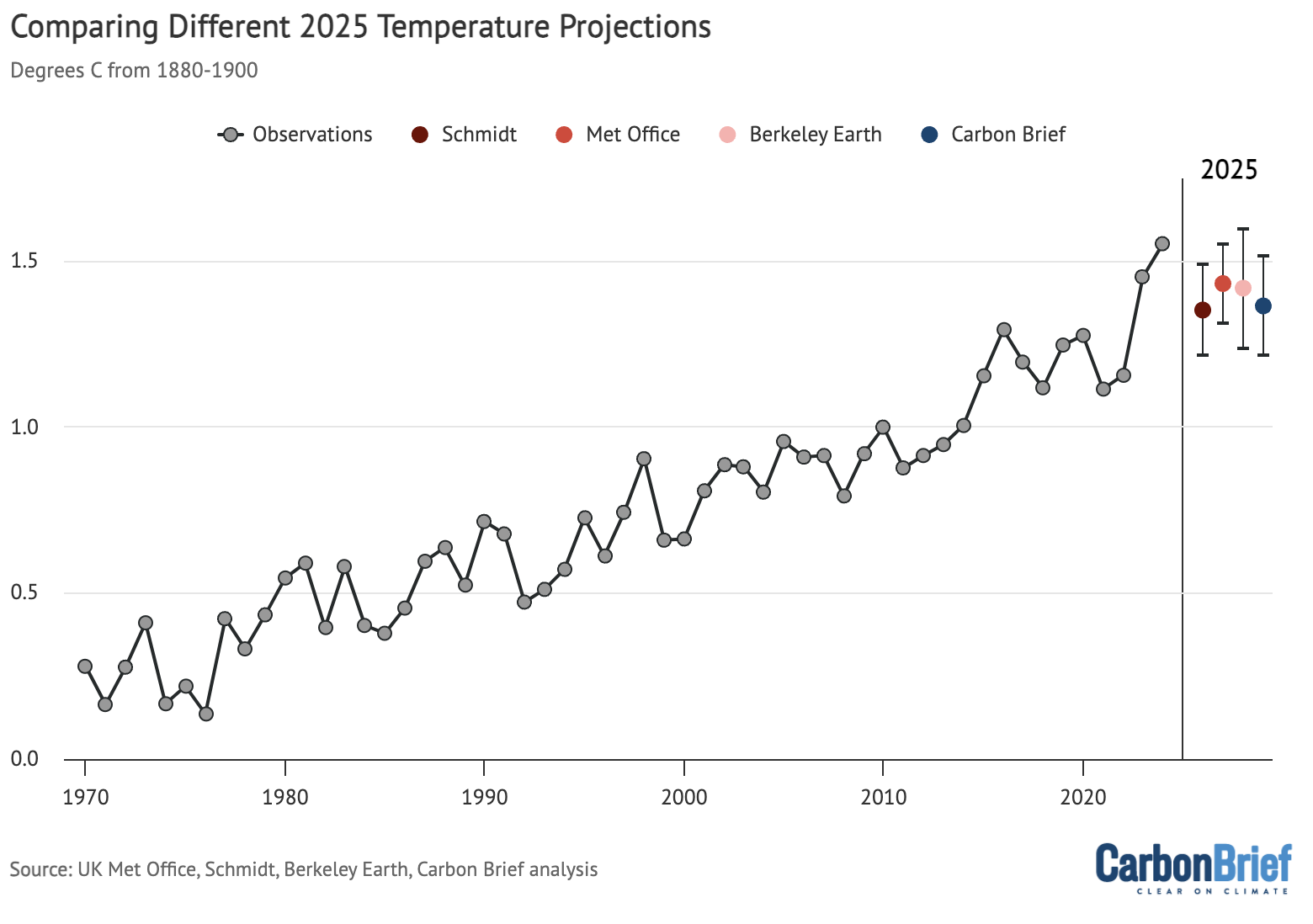
The Met Office, Dr Schmidt, Berkeley Earth and Carbon Brief estimates all have 2025 most likely ending up as the third-warmest year on record, after 2024 and 2023. However, it is still possible that it could be as high as the second-warmest year or as low as the sixth-warmest year, depending on how global temperatures evolve in the coming months.
Against a 1880-99 pre-industrial baseline, the central estimate of all four forecasts for 2025 is around 1.4C warming, with the world relatively unlikely to top 1.5C again next year.
Ultimately, what matters for the climate is not the leaderboard of individual years. Rather, it is the long-term upward trend in global temperatures driven by human emissions of greenhouse gases. Until the world reduces emissions down to net-zero, the planet will continue to warm.
If global emissions remain on the current trajectory, the world will likely firmly pass 1.5C in the late 2020s or early 2030s, as shown in the figure below.
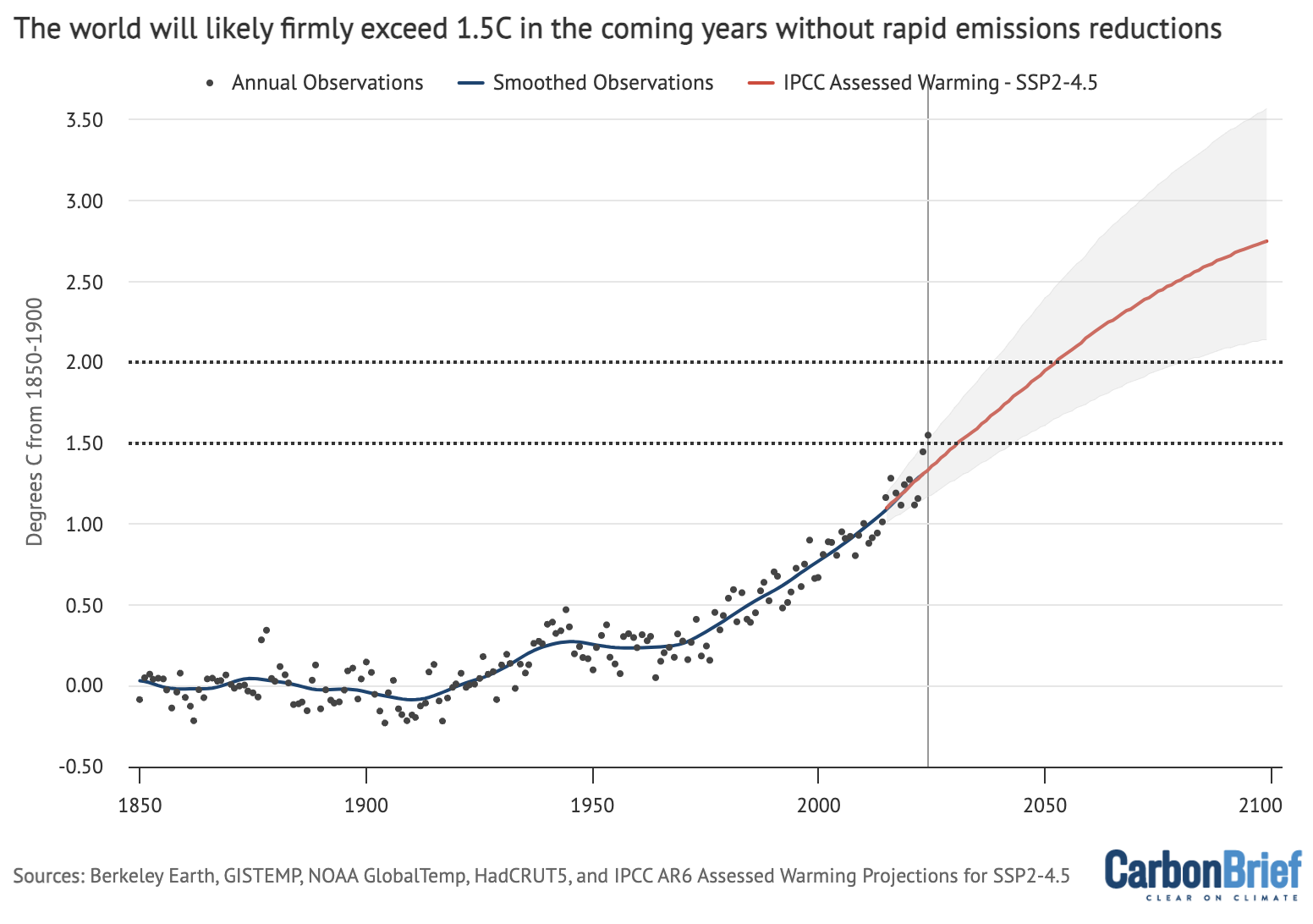
-
State of the Climate: 2024 sets a new record as the first year above 1.5C





